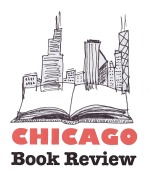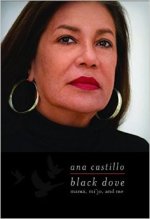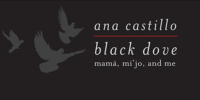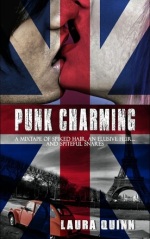 Black Dove:
Black Dove:
Mama, Mi’jo and Me
by Ana Castillo
Best known for her fiction and poetry, Ana Castillo takes a retrospective look at her life in Black Dove: Mama, Mi’jo and Me, a collection of essays. While some of essays were previously published throughout the years, most were written specifically for this collection. All of them weave together to tell Castillo’s life story and that of the two people who have changed her life the most: her mother and her son.
 Unsurprisingly to readers familiar with Castillo’s work, she devotes much of this collection to the strong women in her family. Readers get a glimpse of Castillo’s migratory origins, starting with her mother, who was born in Nebraska but forced to move back to Mexico in poverty. Castillo’s own Chicago upbringing goes back to a time of youth protest (e.g., the Vietnam War), Martin Luther King’s murder, and Iceberg Slim novels. We learn of Castillo’s humble, working-class roots, her early will to explore worlds outside of herself, and parents who, despite wanting the best for their children, remained distant after their long days as factory workers.
Unsurprisingly to readers familiar with Castillo’s work, she devotes much of this collection to the strong women in her family. Readers get a glimpse of Castillo’s migratory origins, starting with her mother, who was born in Nebraska but forced to move back to Mexico in poverty. Castillo’s own Chicago upbringing goes back to a time of youth protest (e.g., the Vietnam War), Martin Luther King’s murder, and Iceberg Slim novels. We learn of Castillo’s humble, working-class roots, her early will to explore worlds outside of herself, and parents who, despite wanting the best for their children, remained distant after their long days as factory workers.
A few essays later, following Castillo’s turbulent entrance into young womanhood, she discusses her struggles as a single, feminist mother raising a son. The journey to nurture a child in a world hostile to black and brown children proves to be a rocky one. Moments of pride mingle with moments of fear and anguish, the culmination of which is revealed when her son, whom she affectionately calls Mi’jo, is sentenced to jail time. Castillo ends the book by coming full circle with the end of her mother’s life and the end of her role as a daughter.
Black Dove is equal parts memoir and family portrait. Castillo narrates her full life with humor and a touch of self-deprecation. Describing a near-death experience in “When I Died in Oaxaca,” Castillo writes, “I may have just suffered the humiliation as a Mexican American not knowing who the Mexican president was at the hour of my death but that didn’t mean my lover had to start treating me like a total gringa.”
If Castillo can’t make sense of life’s events, she can at least make some light of them. Her essays describe injustice in its many forms (e.g., the immigrant’s exploited labor, police surveillance, the prison industrial complex). Castillo also navigates her many identities, each one with its own triumphs and heartbreaks. As a daughter, Castillo reflects on her yearning to know and be close to her mother. As a mother, Castillo reflects on her yearning to prepare and protect her son—now grown with a family—as she knows how, and whether that is enough. As a Chicana, Castillo reflects on her own breed of American. Those identities merely scratch the surface of a complex, dynamic individual.
 Given the largely chronological order of the essays, a few of them seem a touch out of place, such as the piece about Castillo’s near-death experience and a piece toward the end of the book in which she reflects on religion. A few essays may take readers out of the natural flow of Black Dove, though they probably read well on their own.
Given the largely chronological order of the essays, a few of them seem a touch out of place, such as the piece about Castillo’s near-death experience and a piece toward the end of the book in which she reflects on religion. A few essays may take readers out of the natural flow of Black Dove, though they probably read well on their own.
Even while Castillo writes to us as a woman of many identities, the one she emphasizes most is that of a singular person with a story—a story not necessarily worth more or less than anyone else’s, but one that hopefully stays with people similar and different from her. In the book’s introduction, Castillo addresses other Americans and insists that, in spite of differences in origins or politics, as countrypeople we have more in common than we like to believe.
It’s hard to pinpoint just one thing that makes Black Dove worth while, but the sincerity in these pages makes Black Dove an accessible read, both for those familiar and those unfamiliar with Castillo’s work.

May 2016, The Feminist Press at CUNY
Essays/Memoir
$16.95, paperback, 350 pages
ISBN: 978-1-55861-923-4
—Reviewed by Ola Faleti
Read more about local poet, novelist, and essayist Ana Castillo.

 The novel begins with eighteen-year-old Kate embarking on a trip to England where she will complete a study abroad program at Oxford. She is armed with a Walkman full of ’80s music and as many Duran Duran t-shirts that will fit in her suitcase. Upon arriving in Paris, however, she is met with peril and has to use her wits to narrowly avoid catastrophe. Disaster leads to fate, though, when she meets James on a train and it is truly love at first sight.
The novel begins with eighteen-year-old Kate embarking on a trip to England where she will complete a study abroad program at Oxford. She is armed with a Walkman full of ’80s music and as many Duran Duran t-shirts that will fit in her suitcase. Upon arriving in Paris, however, she is met with peril and has to use her wits to narrowly avoid catastrophe. Disaster leads to fate, though, when she meets James on a train and it is truly love at first sight.

